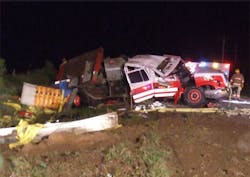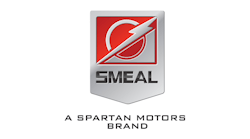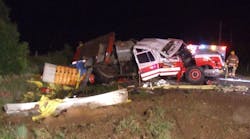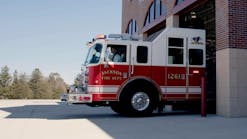Let’s all give thanks the young lady who was driving the engine that rolled in Kansas wasn’t seriously hurt, or worse just over a week ago.
As her family and friends have been saying in social media postings, the 18-year-old, recent high school graduate had angels watching over her the day the she was involved in the wreck of Reno County District Number 3’s engine.
Viewing photos of the crash is enough to convince even the most cynical among us that miracles do occur.
Unfortunately, we can’t always count on miracles to save our souls. Bad things happen to good people. Who among us hasn’t had a white-knuckle moment when driving a 40,000-pound fire engine? If you said no, you’re lying.
There are inherent risks in everything we do as firefighters even before we get to the scene and driving our personal vehicles to the station and apparatus to the scene are among them.
According to a National Fire Protection Association (NFPA) report released earlier last week, 10 firefighters were killed while either operating or riding in road vehicles while on duty in 2012. Five of those victims were not wearing seatbelts and of those five, four were ejected.
Those are sobering statistics. We can be thankful our sister in Kansas had her seatbelt on during her mishap. Otherwise, she would have likely become a statistic too.
As I have said in the past, this blog is not really about training, it’s about stuff. And there’s lots of stuff apparatus builders are doing to keep us safe when it comes to big red trucks and we'll get into that in a minute.
But, I have to take a minute, pull out a soapbox and share my thoughts about apparatus driver operations. It’s my opinion that training is more important than age when it comes to driving fire trucks.
On social networks, there’s been a lot of chatter about the Kansas firefighter being too young to drive apparatus. I happen to agree but only because I don’t think there’s been enough time to put the requisite training in that short time.
The topic is absolutely debatable. Many states have a minimum age of 21 to apply for a commercial license. It’s also true that at least some states exempt firefighters from the requirement of having a CDL to operate fire apparatus during emergencies.
Personally, I feel 18 is too young for a person to drive a fire apparatus, especially during response situations. It has nothing to do with the maturity of the individual, or the level of responsibility and commitment exhibited.
It’s more a practical matter. Teens haven’t quite mastered driving the family minivan, never mind a four-door, top-mount pumper. Yes it’s is possible for people to have received emergency vehicle training and studied for a CDL before graduating high school, but there’s less chance for experience and behind the wheel operations to have taken place.
Casting no aspersions on the lady in Kansas, it’s my humble opinion, the best way to keep firefighters safe behind the wheel of big trucks, and all of those riding in it, is to require CDLs and Emergency Vehicle Operator Certification (EVOC) for those who drive. And, just for the record, I do have both a CDL with a tank endorsement and EVOC.
I know I’m out on thin ice here, particularly with volunteer fire departments who struggle to keep staff and are happy just having people willing to make the commitment and respond.There’s plenty of other fire training that’s required to get the job done – driving is just one more one.
But think about it. Is it worth the risk? Think about the value of the truck. How about human life? Remember the old saying that says we need to get there safely and not be part of the problem.
God Bless our young Kansas firefighter for her willingmess to serve. I hope she continues to serve and, yes, gets behind the wheel of an apparatus just as soon as she can – with a mentor or trainer at her side – advice I’d offer for ANY 18 year old wanting to drive heavy trucks.
And, in the meantime, Reno County is going to be looking for a replacement apparatus and there are lots of new features being used by apparatus builders today to keep firefighters safe.
Virtually all of the apparatus makers today are building units with airbag occupant protection – some rivalling those systems found in high-end automobiles. Airbag protection has evolved from just front impact protection, to side curtain rollover protection, both front and back, and now even knee protection.
All of the apparatus manufacturers that make their own cabs and chassis, including American LaFrance, E-ONE, Ferrara, KME, Pierce, Rosenbauer Smeal, Spartan,and Sutphen have some form of airbag occupant protection. And even builders who manufacture apparatus on provided cabs and chassis offer airbag systems.
Much of the focus on apparatus safety is driven by customer requests and by the National Fallen Firefighter Foundation’s Everyone Goes Home Program.
For years, NFFF has been working with the fire service and manufacturers to prevent line of duty deaths. To that end, it developed 16 Firefighter Life Safety Initiatives. The last one focuses on apparatus design and safety.
A white paper was generated in 2007, written by Daniel Gaumont, chief of the Watertown, N.Y., Fire Department. The 13-page paper details things manufacturers need to do to keep firefighters safe.
And truck builders have been doing a good job meeting that initiative. They’ve spent a lot of money on research and development to come up with roll prevention systems, occupant protection systems, stability systems and, lately, some very sophisticated obstruction sensing systems that will slow apparatus automatically if something in its path is detected. E-ONE introduced that system at a show earlier this year.
It makes anti-lock braking systems (ABS) seem antiquated.
Component makers like Fire Research have long had seat belt monitoring systems alerting the engineer and officer who in the back doesn’t have the safety belt on. That gives the officer the notification necessary to order firefighters to buckle up, and even determine which one he needs to turn around and slap, via an LED on a monitor.
It might be a good idea to put an interlock device on the system so the apparatus won’t move without the belts engaged, but I can hear the cries of “foul” on that one already. Yeah, I know it won’t work which is why it’s probably not a standard feature now.
Cameras are being integrated more and more on apparatus. Rear-view cameras for backing are just the beginning these days as some manufacturers, like Rosenbauer and E-ONE, have incorporated side view cameras.
Not all of the built-in apparatus safety has to be high-tech and electronic.
In fact much of the occupant protection comes from good, solid fabrication of cabs. For years, manufacturers of custom cabs and chassis have been doing crash testing and cab crush testing. They have been testing to European standards which they say are very stringent.
And today, most commercial cab and chassis makers are also doing crash and crush testing. Even the simple and, now, routine components like independent front suspension, disk brakes and tire protection systems help minimum crashes.
When it comes right down to it, the newer the apparatus, the more crash prevention and protection becomes available.
There will come a day when all of this technology, and far more, is standard on apparatus. And when we’re responding, won’t it be good to know that big red truck has our back, just as much as the person sitting next to us.
I can’t wait.










